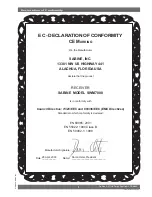
10
Sabine 2.4 GHz Smart Spectrum
®
Wireless
© 2007 Sabine, Inc.
Quick Setups
3.3. Tips for Good RF Performance
•
It is best to keep the system’s channels close together at the low or high
end of the spectrum, i.e. channels 1, 2, 3, 4, 5 or channels 65, 66, 67, 68. If
there is another 2.4 GHz source in the room, grouping the channels reduces
the chances of an overlap. Do not start by spreading your channels through-
out the 70 channel range of the system -- you are more likely to encounter
interference this way.
•
Avoid potential sources of RF interference by performing a scan using
Sabine’s Remote Control Software., which will reveal the ambient RF level
in your area on each channel of your system. Please refer to Section 13.4.2.5.
for information on the RF Scan function, which will automatically determine
the best RF channels to use.
•
If you cannot perform a scan then proceed to use your system, beginning
with Channel 1. If you hear any RF “hits” or dropouts, then move to another
of the 70 available channels. If you have multiple mics keep all your chan-
nels grouped together.
•
For best results, maintain line-of-sight from transmitter to receiver. Use
either front or rear panel antenna mounting to maintain line-of-sight.
•
Mount receiver antennas at 90 degrees to one another, leaning away at 45
degree angles, in the same plane.
•
When using multiple receivers, try to maintain at least 1 foot (30 cm) dis-
tance between antennas from different units. When such antenna spacing
proves difficult or impossible, we recommend using Sabine’s SWA6SS
Antenna Distribution Amplifier. The SWA6SS works with up to six receivers,
or 12 channels.
•
Maximize the distance between the receiver and light sources, such as
fluorescent bulbs or neon signs, which may emit very short-range, broad-
band interference.
•
Maximize the distance between transmitters and receivers and potential
sources of RF interference.
•
Maintain a minimum distance of at least 3 meters (10 feet) between trans-
mitters and receivers or extension antennas. This can solve many anoma-
lies.
•
Turn on your system one component at a time, beginning with the first
receiver.
•
Be careful not to set more than one transmitter to the same channel; each
paired transmitter and receiver should be set to unique corresponding
channels, until all channels are receiving clearly and cleanly.
3.4. Common Sources of RF Interference
•
Microwave ovens: In the vast majority of situations, interference from
microwave ovens will not affect performance of your SWM7000 series mi-
crophone systems. Since barriers such as walls work to block interfer-
ence, a microwave oven will likely present a problem only when located in
fairly close proximity within the same room as the wireless receiver (or
reception antenna). See caution at left.
•
Wireless Local Area Networks (WLANS): These computer network de-
vices allow computers to connect via wireless devices that act as both
receivers and transmitters. These low-powered transceivers often have
selectable channels and can utilize the entire 2.4 GHz band. In general,
Sabine microphones should not be affected by these WLANS because
their spread spectrum technology does not present a problem for the Sabine
Smart Spectrum
TM
system. The Sabine wireless system will not interfere
with the WLAN. See caution at left.
As a general precaution, keep 2.4 GHz
cordless telephones, microwave ovens,
WLAN antennas and 2.4 GHz wireless
video camera transmitters twice the dis-
tance from your Sabine wireless micro-
phone system antennas as that of your
Sabine 2.4 GHz transmitters.
Antenna Placement Caution

























